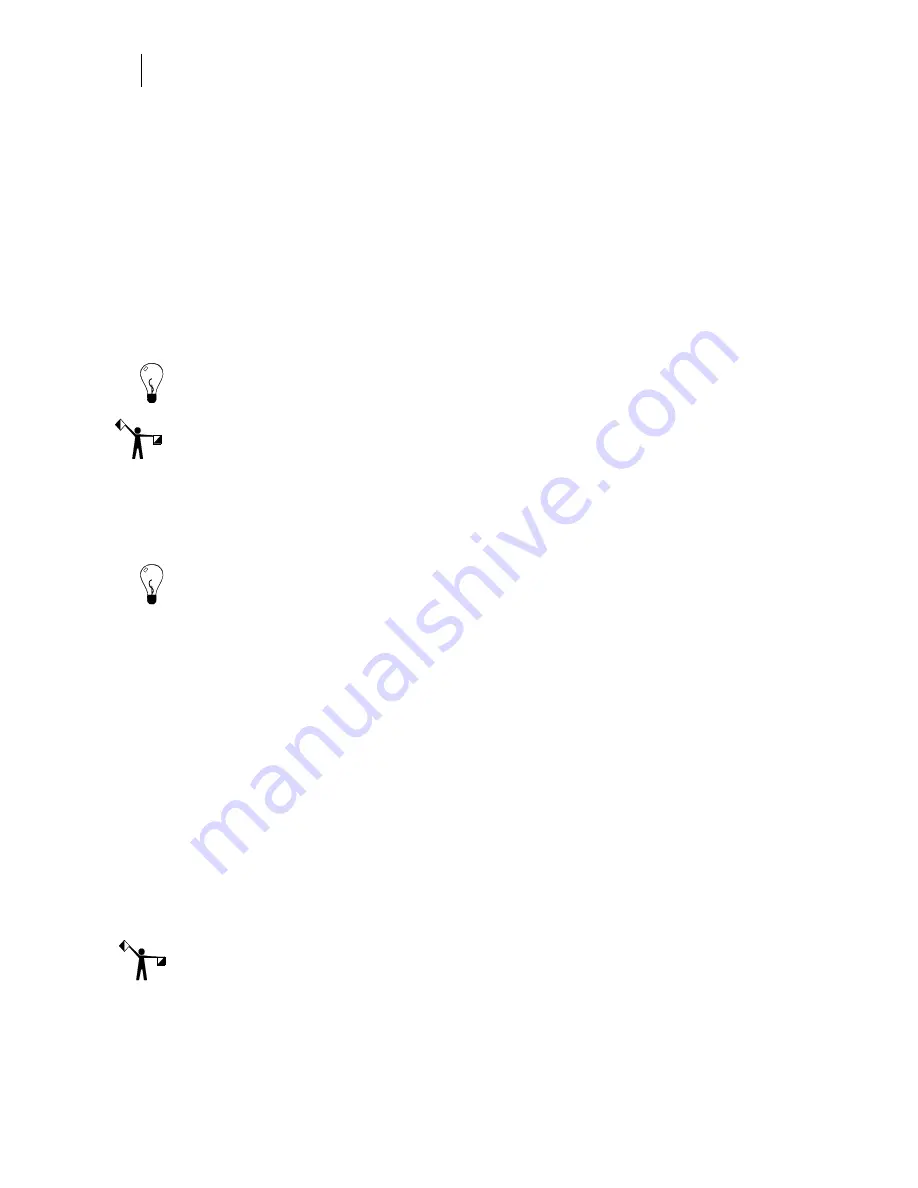
218
Chapter 18:
Choosing and Assigning Halftones
3
In the Fill or Stroke dialog box click Menu > Halftone to open the Edit Halftones
dialog box.
4
Choose a halftone from the Available Types list.
5
If you choose Classical Dot or Spiral Dot, you can change the current LPI by entering a
value in the New LPI text box.
6
Turn on Edit fills and strokes to apply the new settings to both fills and strokes of the
selected object.
7
Click OK to return to the Fill or Stroke tab of the Assign Colors dialog box, then
complete the fill sequence as described in Filling Objects with Color for Printing and
click OK.
Tip: Click the Edit fill halftone button on the Fill toolbar or the Edit stroke halftone button on
the Stroke toolbar to open the Edit Halftones dialog box.
Note: Halftone objects that are in front of other objects may not knock out an underlying color
completely. This void may appear on the top and left sides of the object.
Editing halftones
To edit a halftone, Smart Edit the object or image and change the Halftone Type and LPI in the
dialog box.
Tip: In the Assign Colors dialog box, click Menu > Halftone to open the Edit Halftones dialog
box and make changes in there.
Substituting halftones
The original assignment of the halftone is done in the Assign Colors and Image Fill dialog box
in Composer. Once the job is opened in GSPPlot you can substitute both the halftone type and
the LPI. Click the Halftone button in the Print Order dialog box to display the Substitute
Halftones dialog box. This dialog box has two tabs, one for MAXX printing and the other for
EGDE family printing.
MAXX Tab
When the Substitute Halftones for MAXX check box is turned on you have the ability to choose
your own halftone substitution. In the dialog box below, Classical Dot was substituted for
Classical Dot/53.0. If both the Substitute Halftones for MAXX and Auto-Substitution box are
turned on, the halftone will automatically be substituted for you, using the GerberTone MAXX
halftone. If you want to print with your original halftone, then don't turn on either of the two
check boxes.
Note: If printing a job with a long gradient fill (more than 5 feet long) avoid using Auto-
Substitution. Choose Classical Dot with an LPI setting lower than 26.5 to help prevent
banding that occurs when too small of a halftone dot is used for a linear or radial fill.
When using Classical Dot or Spiral Dot as the substituted halftone type for GERBER MAXX
jobs, you can enter in an LPI value between 4 and 35 LPI. When using GerberTone Maxx, you
cannot substitute the LPI as it is set automatically to be Classical Dot at 26.5 LPI.
Summary of Contents for OMEGA CP
Page 16: ......
Page 20: ......
Page 36: ......
Page 42: ...28 Chapter 4 Saving Files...
Page 44: ......
Page 68: ......
Page 92: ......
Page 96: ...82 Chapter 7 Selecting Elements of the Design...
Page 98: ......
Page 132: ......
Page 146: ......
Page 154: ......
Page 162: ......
Page 182: ......
Page 188: ......
Page 204: ......
Page 234: ......
Page 238: ......
Page 244: ......
Page 254: ...240 Chapter 22 Strokes Adding Print Thickness to the Outline of Objects...
Page 256: ......
Page 282: ......
Page 320: ......
Page 346: ......
Page 358: ......
Page 380: ......
Page 386: ......
Page 418: ......
Page 422: ......
Page 452: ......
Page 462: ......
Page 476: ......
Page 512: ...498 Chapter 44 Creating Special Effects...
Page 514: ......
Page 520: ......
Page 530: ......
Page 540: ......
Page 552: ......
Page 564: ......
Page 606: ......
Page 614: ...600 Chapter 51 Sending the Job to a Plotter or Printer...
Page 694: ......
Page 700: ......
Page 734: ......
Page 748: ......
Page 760: ...746...
Page 776: ......
Page 786: ......
Page 790: ......






























